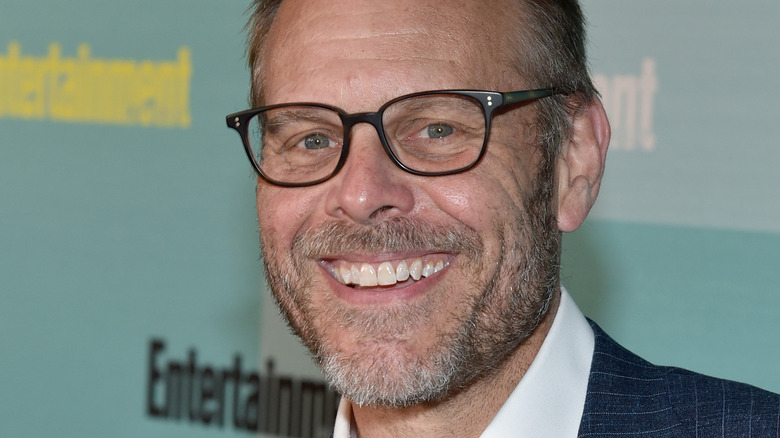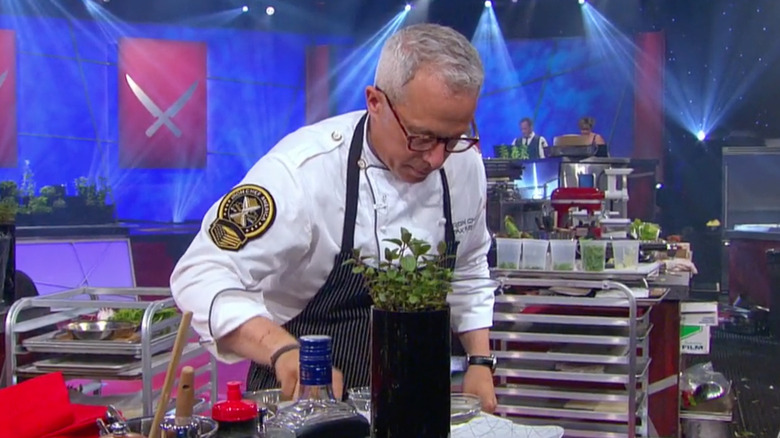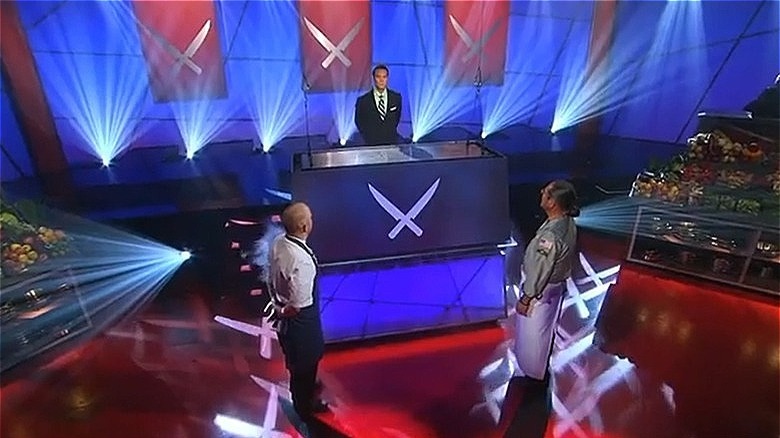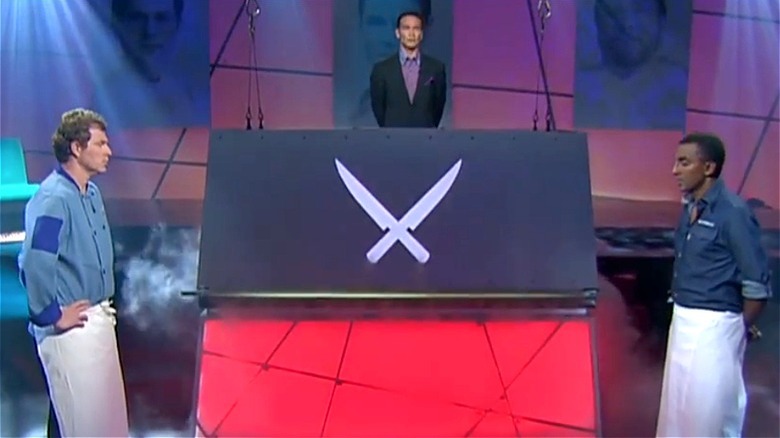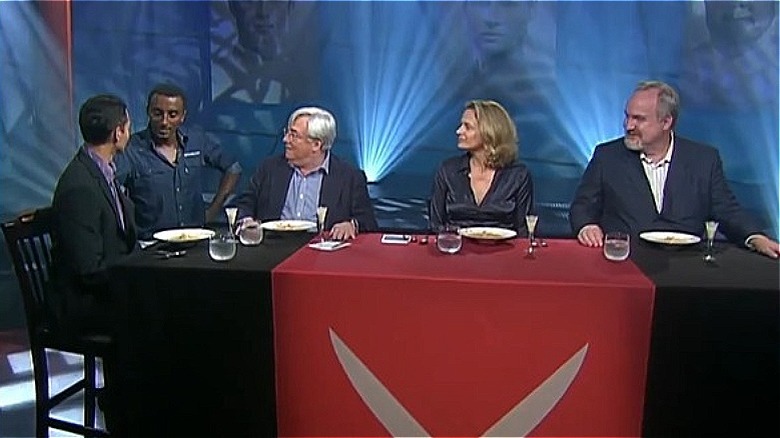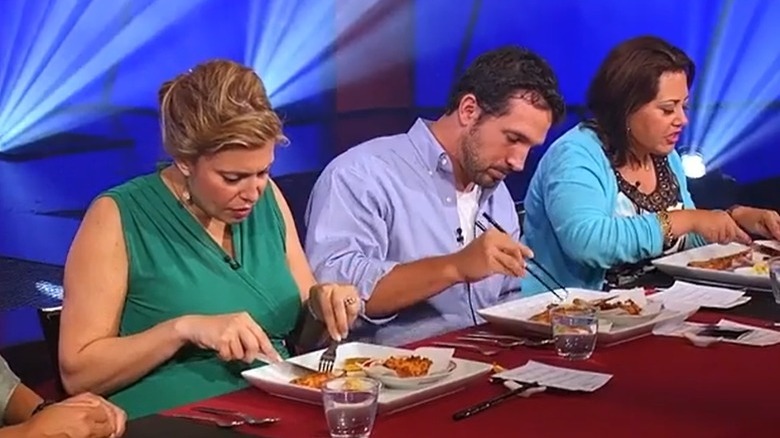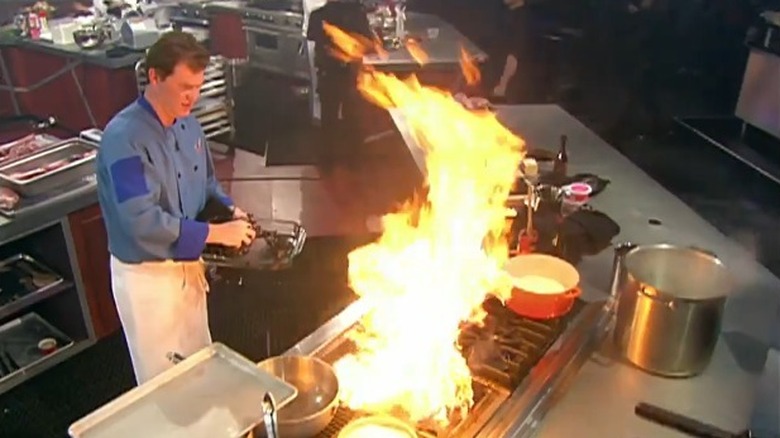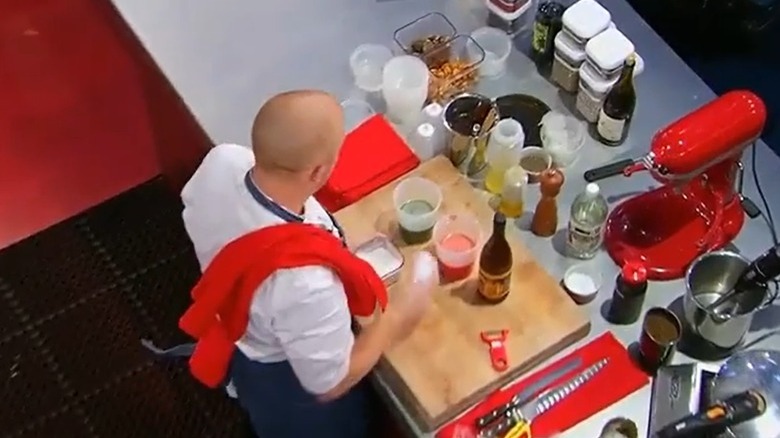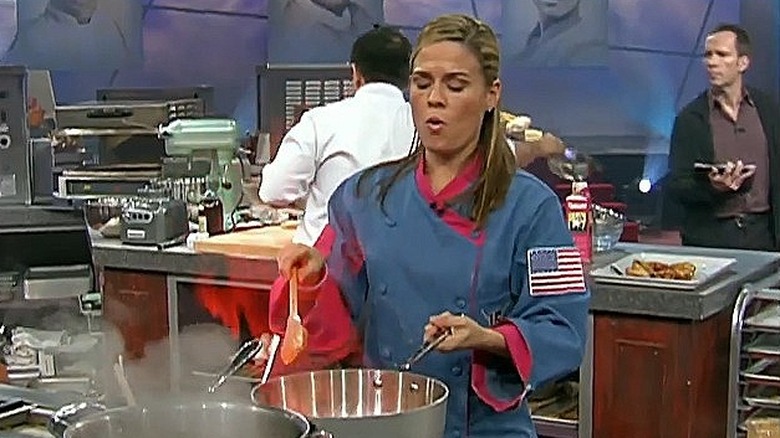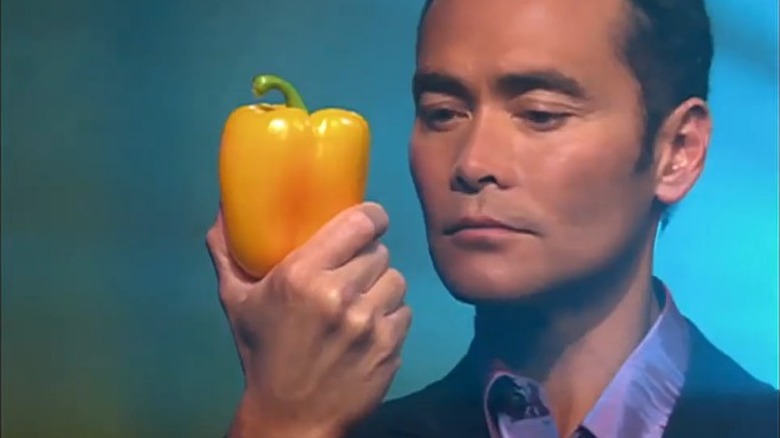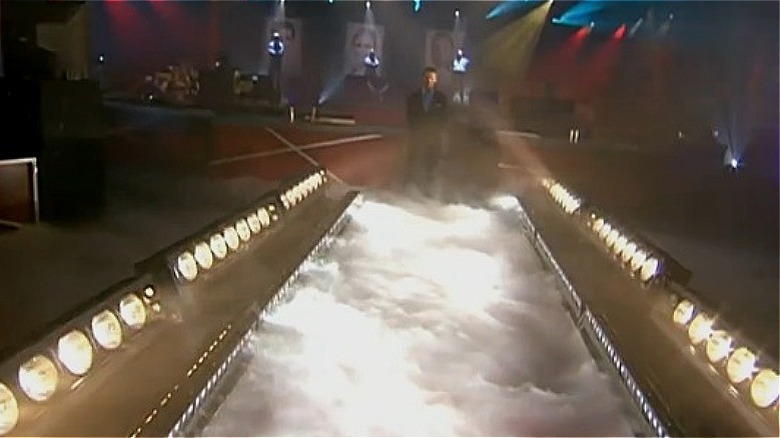What The Cameras Don't Show You On Iron Chef America
"Iron Chef America" could be a valid answer to the question "What's your favorite sport?" After all, it happens in a "stadium," has a live commentator, and includes chefs searing and blending food with an intensity that befits an Olympic event. "Iron Chef America," the show that's based on the Japanese series "Iron Chef," launched in 2005, after a version called "Iron Chef USA" sort of flopped. For the cooking reality show, the second time was the charm, as it wrapped after a whopping 13 seasons in 2018. Per Deadline, Netflix signed a contract in 2022 to reboot the series. The new iteration will be called "Iron Chef: Quest for an Iron Legend" and is set to follow the same format as before.
Each episode pit two accomplished chefs (one is Iron, one is not) in a fast-paced cooking duel, and host Alton Brown broke down the action for the viewers accordingly. What you may not know is that it could take months of preparation — from deciding the secret ingredient to signing up the best chefs from across the country — to create one episode, as culinary producer Jill Novatt told Courant. What may also surprise you is to know that what happened behind the scenes of "Iron Chef America" was sometimes equally riveting as what was captured on camera.
The filming schedule was quite intense
Admit it, one of the draws of "Iron Chef America" is the adrenaline rush. Seeing Chef Masaharu Morimoto julienne his carrot quick as a flash, and Chef Bobby Flay peel a corn at lightning speed can be quite nerve-wracking. For the chefs, there was zero time to snooze, as they were required to make five dishes in one hour. That's less than 15 minutes per dish — about the same time some of us take to make a sammie. What the cameras didn't show you, however, was that the behind-the-scenes crew was hustling hard, too. Per Eater, at The New York Times' "Iron Chef America: Behind the Scenes TimesTalk" discussion in 2010, it was noted that they shot two episodes a day for three weeks straight.
To film an episode of "Iron Chef America" that lasts 40 minutes, it took about five hours, according to DGA Quarterly Magazine. Once the camera started rolling, as per director Eytan Keller, there was no pause option until the battle was done — not even if the chefs happened to be having the worst day with their knives. "You don't want to miss anything that doesn't go right," Keller told the outlet in 2010. That's very schadenfreude of Mr Keller... but, turns out, that's the way reality TV works.
The 'secret' ingredient was not really a secret
Every episode of "Iron Chef America" hinges on a secret ingredient (also the Chairman's swift martial art moves). If you, like us, have a tendency to nitpick just about every scene on the show, surely you would have questioned the sanctity of this ingredient. How hush were they about it, really? Well, as ABC's "Nightline" noted, chefs on "Iron Chef America" did have an inkling of what the ingredient is beforehand. As per the report, the chefs were in fact given three options, one of which would be wheeled into the kitchen stadium right before the battle began. So, why would some chefs chuckle nervously or look shocked by the big reveal? Eh, maybe chalk it up to good acting.
Judge Andrew Knowlton told "Nightline," "I think to just say you have no idea what the ingredient is when you come in is impossible, because you have to stock the kitchen [...] You have to have certain stuff that the chefs want. It's logistics." But, obviously, the cameras don't give that away. The suspense and the eventual shock is a good sell — and if the secret ingredients are as strange as a gigantic elk carcass, or a humongous large-scaled fish, viewers would definitely buy it. At least some of us did.
The matchups were planned in advance
Every episode of "Iron Chef America” commenced with a guest chef (aka Challenger) picking an Iron Chef to battle it out at the Kitchen Stadium. This is a big deal, as the chef's decision charts the course of the entire episode... and your evening plans. No one wants to spend an hour watching a chef they don't like, do they? But if you ever found yourself crossing your fingers that a certain Iron Chef would be picked on an episode, you might've just been wasting your time. As Reality Blurred's Andy Dehnart explained in a Today Q&A, the decision of who battles who was figured out long before the sequence unfolded in front of the cameras.
In the show, dramatic music accompanied the introduction of the Iron Chefs — a roster that included Bobby Flay, Mario Batali, Masaharu Morimoto, Cat Cora, Jose Garces, Michael Symon, Marc Forgione and Geoffrey Zakarian — as they awaited the big decision. However, in reality, it did not quite happen like this. As restaurant critic Robert Seitsema wrote in The Village Voice following a taping, among the three Iron Chefs who were introduced for the challenger to pick from, two were stand-ins — one was dressed like Mario Batali (easy, we presume, because of the trademark orange clogs), and the other impersonated Bobby Flay. The third was chef Marimoto, the real one, and of course, he was the one chosen for that episode. It's all pre-decided.
A coin flip played a big part
After the grueling race against time, the chefs simply flipped a coin to decide whose dishes get served to the judges first, per Eater. Cameras skipped the flip and went straight to showing the viewers the hastily (but efficiently) prepared dishes being presented to a panel. While it may seem as if the food was whisked from the station to the judging table with zero recess time, in reality, things pivot into slow motion once the battle is complete. After sitting in the audience for the show's taping, restaurant critic Robert Sietsema wrote in The Village Voice, "The finished concoctions—many involving raw fish—languished on a side board as the judges ambled around and production people wiped their brows and relaxed." It took 45 minutes for the judging to begin; and once it did, it went on for 90 minutes, 45 minutes for each chef.
But, here is the shocker: According to a panel hosted by The New York Times in 2010, the judges actually did not taste the food which the chefs cooked on the show. Per Eater, they told the audience that entirely separate dishes were whipped up for the judges to try. Per The Village Voice, the second iteration of the dishes are typically executed by sous chefs. Well, that explains the coin flip. Doesn't matter who goes first, the food is made fresh anyway.
The judges didn't always look forward to the dishes
Being a judge on "Iron Chef America" meant enjoying a course of 10 dishes served by the best chefs in the country. But was the job really as dreamy as it sounds? Apparently not. Though the judges didn't show it on camera, turns out, they were not always pumped to try the unique creations. Andrew Knowlton, a restaurant editor for Bon Appetit Magazine and a past judge on the show, admitted that there were times he did not look forward to digging in. "When you have battle quail or battle turkey and you see the ice cream [machine] flip on [...] you're like, 'Oh great, here we go again. Some more turkey ice cream! Just had that last night," he said on ABC's "Nightline."
The chefs did get points for originality (besides taste and plating), but as food and travel author Simon Majumdar told Food Network, there was a limit to how far they can push it."If I ever see a chef walking towards the ice cream machine with a duck breast, you can be pretty sure they are going to lose," he said. On the other hand, what annoyed the chefs was having judges from a non-culinary background. Chef Cat Cora likened it to her judging an "olympic swimming event" that she knew nothing about; Mario Batali told The Atlantic that a lack of expert judges is also what pushed chef to quit the show in 2014.
There was a big crew behind the scenes
"This is, I think, more of an athletic event," the show's host Alton Brown once said of an episode on ABC's "Nightline." Between the need for speed, and the pressure to win, the show can seem less about the pleasure of cooking, and more like a gauntlet. As many as 127 crew members were involved in the filming of one episode to ensure that all the action on the stage was captured, per "Nightline." There were multiple camera operators, and their responsibilities went beyond just recording the show. As he shared in a 2010 chat with DGA Quarterly Magazine, director Eyton Keller expected them to intuit the chef's next move, and position the cameras accordingly. And they used all sorts of cameras to achieve their goal.
The mission, according to Keller: "Viewers should feel they were there in the moment with the chefs." This can be particularly challenging given everything happened so quickly. There was a stage manager, Patty Ricardella, who ensured filming went smoothly. "It's like a freight train ... I direct the traffic on the show and keep things moving," Ricardella told DGA Quarterly. Eventually, Keller has to cut down the one-hour recording of the kitchen battle into a 30-minute episode while making sure no important footage of the ingredients or process gets cut out.
The chefs got money for specialty groceries
Except for the "secret" ingredient, the rest of the "Iron Chef America" pantry could be custom ordered by the chefs for each episode. This means that it was not always a set list of groceries that they have at their disposal. While a basic pantry was provided by default, each chef could also spend an extra $500 to order specialty items that they would like to use in an episode, per ABC's "Nightline." As Eater reported, Iron Chefs Bobby Flay and Jose Garces shared at The New York Times' "Iron Chef America: Behind the Scenes TimesTalk" that they did make little changes to their pantry stock, but Iron Chef Masaharu Morimoto, turns out, hates monotony. Host Alton Brown once said in an interview with Archive of American Television that he could always count on Morimoto to keep everyone on their toes.
Per Brown, Morimoto used a lot of ingredients, and was super secretive about his pantry. To make sure he wasn't caught by surprise while the cameras were on, Brown had to keep a spy in Morimoto's organization so that he knew every single ingredient that the chef planned to cook with. "He'll sneak stuff in and have it hit the counter," said Brown. But besides appointing spies, Brown himself checked in at the sets early enough to take a look at each chef's selection of ingredients for the day, long before the cameras started rolling.
The competition unfolded before a live audience
You hardly see them on television, but there was always an audience of around 50 on the sets of "Iron Chef America." As mentioned on The Amateur Gourmet, the live show was an invite-only event, and those who were fortunate enough to be on it had to sign an NDA that bans them from revealing important details of an episode (such as what the secret ingredient was, or which Iron Chef was chosen), failing which they would have to pay a million dollar fine. Yes, a million.
Some who finally made it to the show at the Food Network studios in New York City, like The Amateur Gourmet founder Adam Roberts, weren't totally impressed by the experience. "The space was surprisingly small and fake-looking," he wrote. "And with all the stops and starts and editing and lack of music, a live performance of Iron Chef America is as tense as watching two 90 year olds play a game of hopscotch." As per restaurant critic Robert Sietsema's review of the show's taping for The Village Voice, the live version apparently lacked the drama that the edited version brought on to the screen. Siestsema said, "The two hours of judging were a colossal bore, and several of the guests found ways of sneaking away." He added that even Iron Chef Masahari Morimoto appeared unexcited despite being crowned the champion.
The Chairman was called so even behind the scenes
The Chairman, if you really think about it, did not have a ton to do on "Iron Chef America" beyond saying the phrase "Allez! Cuisine!' with a sense of authority. Even so, the character is an important part of the franchise; inspired by Takeshi Kaga's original Chairman in the Japanese version of the series, the U.S. iteration brought on actor Mark Dacascos to play the "nephew."
But before the Chairman role went to Dacascos, it was apparently offered to Alton Brown. However, as he told Archive of American Television, the part didn't appeal to him. "I was like, 'Why do you want to be the Chairman, that's not really fun. You stand around a lot, bite something,'" he recalled. Brown went with the host role instead. Some Redditors feel a bit differently about the gig, with one writing, "Getting paid to eat good food and just sort of... be there? Sounds perfect to me."
Evidently, the Chairman didn't drop character when the cameras weren't rolling. As restaurant critic Robert Seitsema wrote in The Village Voice, "[The Chairman] is always deferentially addressed by the director and other production people as 'The Chairman' rather than by his actual name."
A lot of ice went into creating the fog effect
As if the duel between two top chefs wasn't dramatic enough, "Iron Chef America" always made a point to fill the stage with plumes of fog for some added panache. The thick smoky effect was used rather generously throughout the show — be it when a guest chef first walked on to the stage, when the Iron Chefs were introduced on their raised pedestals, or when the secret ingredient was unveiled by the Chairman. ABC's "Nightline" found that as much as 150 pounds of dry ice were used to keep the venue perpetually cloudy. As noted in the book "Special Effects: An Introduction to Movie Magic," when dry ice comes in contact with hot water, it creates dense fog like the one that "Iron Chef America" viewers are so familiar with.
According to restaurant critic Robert Seitsema, fog was continuously pumped all through the taping he attended, clouding large portions of sets, including Seitsema himself. "As far as I could tell from the monitors, it didn't matter where the guests sat, since you can't see their faces anyway, enveloped as they were in fog," he wrote in The Village Voice. Dry ice has another purpose too: According to a report published in DGA Quarterly Magazine, the secret ingredient was kept fresh in dry ice until it was time for the big reveal.
